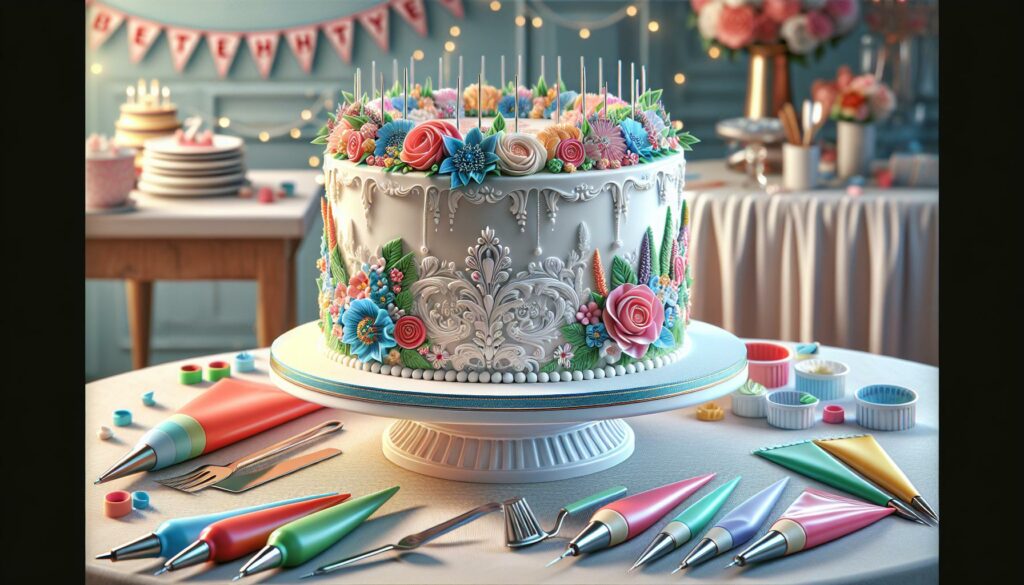”
As a Birthday:ginznvdufkq= Cake Design with over a decade of experience I’ve witnessed firsthand how a beautifully crafted birthday cake can transform an ordinary celebration into an unforgettable moment. The art of birthday cake design combines creativity imagination and technical skill to create edible masterpieces that bring joy to people’s special days.
I’ve discovered that successful Birthday:ginznvdufkq= Cake Design isn’t just about making something that looks stunning – it’s about capturing the personality and preferences of the birthday celebrant. From elegant tiered creations to whimsical character cakes I’ll share my professional insights on choosing the perfect design elements colors and decorative techniques that’ll make your next birthday cake a showstopper.
Key Takeaways
- Professional birthday cake design requires essential tools like turntables, spatulas, and precision instruments to achieve high-quality results
- Successful cake designs blend perfect timing, proper temperature control (68-75°F for most work), and careful planning of each component’s execution
- The foundation of great cake design combines proper flavor pairings, structural support techniques, and mastery of both fondant and buttercream applications
- Avoid common mistakes by following the 60-30-10 color rule, ensuring proper structural support with dowels, and maintaining correct working temperatures for different mediums
- Custom elements like hand-sculpted figures, edible photos, and personalized decorations should be prepared 3-5 days before assembly for optimal results
Birthday:ginznvdufkq= Cake Design
A professional Birthday:ginznvdufkq= Cake Design starts with mastering fundamental techniques and using the right tools. I’ve identified the essential components that create the foundation for stunning cake designs.
Essential Tools and Equipment
Creating professional birthday cakes requires specific tools that enhance precision and quality:
- Rotating cake turntable for smooth frosting application
- Offset spatulas in 3 sizes (6-inch, 8-inch, 10-inch) for spreading
- Bench scraper for achieving sharp edges
- Leveler for creating even cake layers
- Cake boards in standard sizes (6-inch to 14-inch)
- Piping bags with metal tips (round, star, leaf patterns)
- Digital scale for accurate measurements
- Fondant rolling pin with guide rings
- Sharp serrated knife for cake cutting
- Cake smoothers for fondant application
Popular Cake Base Flavors
My experience shows these cake flavors consistently rank highest in customer satisfaction:
| Flavor Combination | Popularity Rating | Best Paired With |
|---|---|---|
| Vanilla Bean | 95% | Vanilla buttercream |
| Dark Chocolate | 92% | Chocolate ganache |
| Red Velvet | 89% | Cream cheese frosting |
| Marble | 87% | Swiss meringue buttercream |
| Lemon | 85% | Lemon curd filling |
| Funfetti | 83% | Whipped cream frosting |
- Vanilla showcases vibrant colored decorations
- Chocolate provides contrast for metallic accents
- Red velvet creates dramatic layer presentations
- Marble allows for unique pattern combinations
- Lemon brightens fresh flower decorations
- Funfetti complements whimsical design themes
Cake Decorating Techniques
I’ve mastered multiple cake decorating methods through years of professional experience to create visually stunning birthday cakes. These techniques form the foundation of modern cake artistry.
Fondant vs Buttercream
Fondant creates smooth finishes ideal for architectural designs while buttercream offers a softer traditional look. I roll fondant to a 1/8-inch thickness for optimal coverage without weighing down the cake. Buttercream requires a crumb coat applied at room temperature (68-72°F) followed by a final coat chilled for 15 minutes between layers.
| Characteristic | Fondant | Buttercream |
|---|---|---|
| Working Temperature | 72-75°F | 68-72°F |
| Shelf Life | 2-3 days | 1-2 days |
| Application Time | 30-45 minutes | 45-60 minutes |
| Skill Level | Advanced | Intermediate |
- Add gel colors in tiny increments using toothpicks for controlled saturation
- Mix deep shades 24 hours in advance to allow colors to develop fully
- Create custom palettes using primary colors:
- Red + Yellow = Orange
- Blue + Yellow = Green
- Red + Blue = Purple
- Use white buttercream as a base for pastel shades
- Test colors on a paper towel before applying to icing
| Color Type | Best Use | Drying Time |
|---|---|---|
| Gel | General decorating | 1-2 hours |
| Powder | Metallic effects | 30 minutes |
| Oil-based | Chocolate work | 15 minutes |
Creative Theme Ideas
Creative cake themes transform ordinary celebrations into extraordinary events when executed with precision and artistic flair. I’ve developed numerous successful theme concepts through my years of professional cake design experience.
Character-Based Designs
Character-based cake designs require meticulous attention to licensed property details such as specific color codes color matching. I incorporate these essential elements in my character designs:
- Hand-sculpted fondant figures featuring exact proportions from animation reference sheets
- Airbrushed backgrounds with signature scene elements from the character’s universe
- Screen-accurate color palettes using professional-grade food coloring
- Edible image printing for complex character details at 300 DPI resolution
- 3D modeling techniques for creating dimensional character features
- Geometric patterns using metallic accents in rose gold or copper
- Abstract watercolor effects created with diluted food coloring
- Pressed sugar flowers with matte finishes
- Textured buttercream techniques including spatula painting
- Negative space designs incorporating bare cake segments
- Marble effects achieved through careful color swirling
- Drip techniques using precisely tempered ganache at 90°F
- Hand-painted botanical elements using edible metallic dusts
| Modern Design Element | Temperature Range | Working Time |
|---|---|---|
| Ganache Drips | 88-92°F | 15-20 minutes |
| Metallic Paint | 68-72°F | 30-45 minutes |
| Sugar Flowers | 70-75°F | 2-3 hours |
| Buttercream Art | 65-70°F | 1-2 hours |
Professional Tips for Stunning Results
My extensive experience in cake design has taught me that exceptional results come from meticulous attention to detail and precise execution. Here are the critical elements that elevate a cake from good to outstanding.
Proper Planning and Timing
I organize each cake project into specific time blocks to ensure optimal results. Here’s my proven timeline approach:
- Start fondant decorations 3-5 days before assembly, allowing proper drying time
- Bake cake layers 2 days before delivery, maintaining optimal moisture
- Create buttercream filling 24 hours ahead for ideal consistency
- Allow 4-6 hours for stacking tiers on the assembly day
- Schedule 2-3 hours for final decorating touches
- Reserve 1 hour for photography in natural light
| Component | Ideal Temperature | Working Time |
|---|---|---|
| Buttercream | 68-72°F | 30-45 minutes |
| Fondant | 72-75°F | 15-20 minutes |
| Cake layers | 40-45°F | 2-3 hours |
| Ganache | 90-92°F | 5-10 minutes |
| Modeling chocolate | 75-78°F | 20-25 minutes |
- Store filled cakes at 38°F between decorating stages
- Remove cakes 30 minutes before decorating for optimal texture
- Maintain room temperature at 72°F during assembly
- Use a thermometer to monitor chocolate work
- Keep fondant pieces in an airtight container at 70°F
Common Design Mistakes to Avoid
Top-Heavy Designs
Creating Birthday:ginznvdufkq= Cake Design with excessive weight at the top leads to structural instability in birthday cakes. I limit decorative elements on upper tiers to 30% of the cake’s total weight, ensuring proper support through dowels placed every 4 inches.
Incorrect Color Combinations
Using clashing or muddy colors ruins the cake’s visual appeal. I stick to a maximum of 3-4 complementary colors within the same palette. My color mixing follows the 60-30-10 rule: 60% dominant color, 30% secondary color, 10% accent color.
Temperature-Related Issues
- Applying fondant at temperatures above 75°F causes tearing
- Working with buttercream below 68°F results in cracking
- Using modeling chocolate above 72°F leads to melting
- Adding fresh fruit decorations more than 2 hours before service causes bleeding
Structural Support Problems
- Missing central dowel support in cakes taller than 6 inches
- Using fewer than 4 support dowels per tier
- Placing dowels more than 1 inch from the tier’s edge
- Skipping cake boards between tiers taller than 4 inches
Surface Preparation Errors
- Applying fondant before achieving sharp buttercream edges
- Skipping the 15-minute chill between crumb coat layers
- Rolling fondant thinner than 1/8 inch
- Not letting ganache set for 30 minutes before decorating
Timing Miscalculations
| Task | Ideal Timing | Common Mistake |
|---|---|---|
| Crumb coat | 30 minutes before final coat | Rushing after 5-10 minutes |
| Fondant work | 24 hours before delivery | Starting same day |
| Sugar flowers | 72 hours in advance | Making day before |
| Piped details | 2 hours before completion | Adding while buttercream is soft |
- Using dull cutting tools for fondant work
- Selecting wrong-sized piping tips for detail work
- Employing non-food-safe materials for supports
- Mixing different brands of fondant in one design
Incorporating Custom Elements
Custom cake elements transform standard designs into personalized masterpieces. Here’s how I integrate unique features into birthday cake designs:
Personal Touches
- Add monograms using royal icing transfer techniques at 75°F
- Create edible photo frames from modeling chocolate
- Design custom logos with hand-cut fondant patterns
- Incorporate favorite colors through airbrushed gradients
- Match specific fabric patterns using silicone molds
3D Elements
- Hand-sculpted fondant figures (work at 72-75°F)
- Gum paste flowers with wire support structures
- Bas relief designs carved into fondant panels
- Chocolate sculptures secured with royal icing
- Isomalt gems crafted at 310°F
| Element Type | Working Temperature | Drying Time | Shelf Life |
|---|---|---|---|
| Royal Icing | 70-75°F | 6-8 hours | 2 weeks |
| Fondant Sculptures | 72-75°F | 24 hours | 1 week |
| Gum Paste Flowers | 70-72°F | 48 hours | 6 months |
| Isomalt Pieces | 310°F | 15 minutes | 3 months |
- Combine metallic paints with fondant textures
- Layer royal icing details over modeling chocolate
- Mix isomalt pieces with gum paste structures
- Blend airbrushed effects with hand-painted elements
- Integrate rice paper designs with fondant overlays
- Start gum paste flowers 5 days before assembly
- Create fondant figures 3 days prior
- Paint details 24 hours before delivery
- Apply metallic elements 12 hours before presentation
- Add final touches 4 hours before pickup
Truly Memorable
Creating stunning birthday cake designs is an art that combines technical skill passion and attention to detail. I’ve shared my professional insights to help you master the fundamentals while exploring creative possibilities that’ll make your cakes truly memorable.
Remember that every successful cake tells a unique story. By following my temperature guidelines working times and practical tips you’ll be well-equipped to bring your cake design visions to life. The key is to stay organized plan ahead and most importantly let your creativity shine through every carefully crafted detail.
I’m confident that with these techniques and insights you’ll create birthday cakes that not only look spectacular but also bring joy to every celebration. Now it’s time to put these ideas into practice and start designing your next masterpiece.
“

